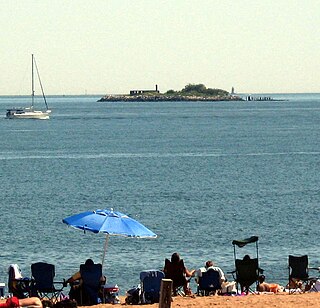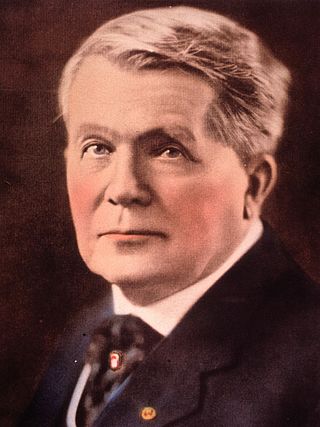
A quarantine is a restriction on the movement of people, animals, and goods which is intended to prevent the spread of disease or pests. It is often used in connection to disease and illness, preventing the movement of those who may have been exposed to a communicable disease, yet do not have a confirmed medical diagnosis. It is distinct from medical isolation, in which those confirmed to be infected with a communicable disease are isolated from the healthy population.

The National Institutes of Health, commonly referred to as NIH, is the primary agency of the United States government responsible for biomedical and public health research. It was founded in 1887 and is now part of the United States Department of Health and Human Services. Many NIH facilities are located in Bethesda, Maryland, and other nearby suburbs of the Washington metropolitan area, with other primary facilities in the Research Triangle Park in North Carolina and smaller satellite facilities located around the United States. The NIH conducts its own scientific research through the NIH Intramural Research Program (IRP) and provides major biomedical research funding to non-NIH research facilities through its Extramural Research Program.

The United States Public Health Service is a collection of agencies of the Department of Health and Human Services concerned with public health, containing nine out of the department's twelve operating divisions. The Assistant Secretary for Health oversees the PHS. The Public Health Service Commissioned Corps (PHSCC) is the federal uniformed service of the PHS, and is one of the eight uniformed services of the United States.

The Marine Hospital Service was an organization of Marine Hospitals dedicated to the care of ill and disabled seamen in the United States Merchant Marine, the U.S. Coast Guard and other federal beneficiaries. The Marine Hospital Service evolved into the U.S. Public Health Service.

John Brown Hamilton was an American physician and soldier. He was appointed the second Surgeon General of the United States from 1879 to 1891.

Swinburne Island is a 4-acre (1.6 ha) artificial island in Lower New York Bay, east of Staten Island in New York City. It was used for quarantine of immigrants. Swinburne Island is the smaller of two nearby islands, the other being Hoffman Island to the north.

The 46th United States Congress was a meeting of the legislative branch of the United States federal government, consisting of the United States Senate and the United States House of Representatives. It met in Washington, D.C. from March 4, 1879, to March 4, 1881, during the last two years of Rutherford Hayes's presidency.

The Public Health Service Act is a United States federal law enacted in 1944. The full act is codified in Title 42 of the United States Code, Chapter 6A . This Act provided a legislative basis for the provision of public health services in the United States.

An Act to protect the commerce of the United States and punish the crime of piracy is an 1819 United States federal statute against piracy, amended in 1820 to declare participating in the slave trade or robbing a ship to be piracy as well. The last execution for piracy in the United States was of slave trader Nathaniel Gordon in 1862 in New York, under the amended act.

Texas Gulf Coast is an intertidal zone which borders the coastal region of South Texas, Southeast Texas, and the Texas Coastal Bend. The Texas coastal geography boundaries the Gulf of Mexico encompassing a geographical distance relative bearing at 367 miles (591 km) of coastline according to CRS and 3,359 miles (5,406 km) of shoreline according to NOAA.

The Intelligence Authorization Act for Fiscal Year 2014 is a U.S. public law that authorizes appropriations for fiscal year 2014 for intelligence activities of the U.S. government. The law authorizes there to be funding for intelligence agencies such as the Central Intelligence Agency or the National Security Agency, but a separate appropriations bill would also have to pass in order for those agencies to receive any money.

Joseph Nathaniel McCormack was an American surgeon, a leader in several national medical organizations and a member of the Kentucky General Assembly. He served as executive officer of the Kentucky State Board of Health for thirty years and he led the reorganization of the American Medical Association (AMA) during its formative years of 1900 to 1911. James Burrow, historian of the AMA, has written that McCormack was "the most influential political leader of the profession in the Progressive Era, or perhaps in the AMA's entire history." McCormack served for six years as president of the Association of State and Territorial Health Officials and for two years as president of the Federation of State Medical Boards. In 1907 the American Association for the Advancement of Science included him in its list of the 100 most influential leaders in the fields of medicine, public health, science and social reform.

Tea Importation Act of 1897 was a United States public law forbidding the import of tea into the United States with excessive levels of fluoride, heavy metals, oxalate, and pesticides. The Act of Congress established a uniform standard of purity and quality while attempting to achieve the optimal health effects of tea and phenolic content in tea. The statute declared it unlawful to import into the United States "any merchandise as tea which is inferior in purity, quality, and fitness for consumption to the standards kept at customhouses..." For nearly a century, Congress provided that no imported tea could enter the United States unless federal tea-tasters decided that it measured up to preselected standard samples. The law restricted the International trade of camellia sinensis.

La Follette–Bulwinkle Act or Venereal Diseases Control and Prevention Act of 1938 sanctioned federal assistance to U.S. states establishing preventive healthcare for venereal diseases. The United States federal statute commissioned the United States Public Health Service for demonstrations, investigations, and studies as related to the control, prevention, and treatment of opportunistic infections. The public law amended the Army Appropriations Act of 1918 appending the judicial context which created the Division of Venereal Diseases within the Bureau of the Public Health Service.
This is a timeline of the United States Public Health Service Commissioned Corps and its predecessor, the Marine Hospital Service.
The National Board of Health (NBH) was a short lived institution that operated from 1879 to 1883 in the United States. It was created during the third Session of the 45th Congress, listed as chapter 202 better known as the Public Health Act of 1879. The purpose of the NBH was to carry out a piece of legislation passed in Session I of the 45th Congress, Chapter 66. Chapter 66 and Chapter 202 were redundant pieces of legislature in all aspects but one: the implementation and oversight of the NBH.

Federal Mines Safety Act of 1910 was a United States statute passed for the purposes of establishing the United States Bureau of Mines as a federal agency of the United States Department of the Interior. The Act of Congress authorized investigations of mining methods with an emphasis regarding the safety of miners while recovering combustible fossil fuels and confronting occupational dust exposure.

The Division of Global Migration Health (DGMH), formerly the Division of Global Migration and Quarantine is the part of the U.S. government responsible for U.S. Quarantine Stations and issuing quarantine orders. It is part of the National Center for Emerging and Zoonotic Infectious Diseases within the Centers for Disease Control and Prevention (CDC).

National Quarantine Act of 1878 established quarantine regulations for foreign nautical vessels pursuing entrance into United States maritime ports. The United States statute declared it to be an unlawful pursuit for international vessels departing harbors termed as infected maritime ports to enter United States seaports and territorial waters. The Act of Congress authorized the prevention of communicable and transmissible diseases from entering or being introduced by any vehicle beyond the borders of the United States.

Dorland Jones Davis was an American physician, commissioned officer in the U.S. Public Health Service (PHS). He was the director of the National Institute of Allergy and Infectious Diseases from 1964 to 1975. Davis was born in Chicago, Illinois, on July 2, 1911. He received a B.S. degree from the University of Illinois in 1933, an M.D. degree from Johns Hopkins University in 1937, and a DrPH degree from Johns Hopkins in 1940.












